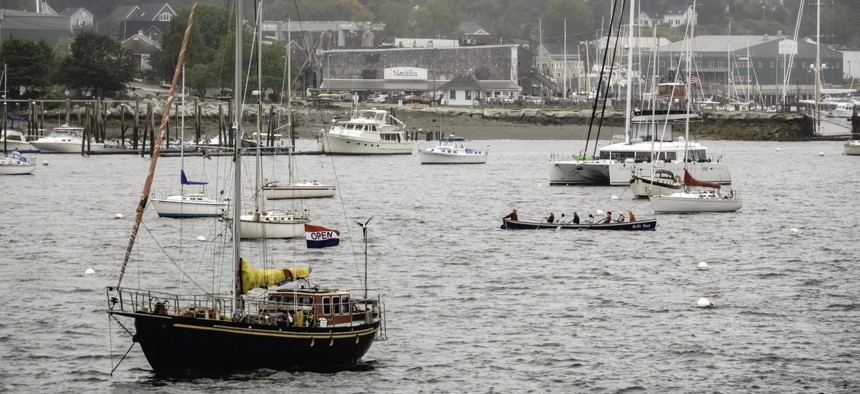Onshore Fish-Farming Proponents Have a New Arrow in Their Quiver

Balfast, Maine sits along Penobscot Bay Shutterstock
A Deloitte report sees worldwide potential for technology being deployed in Maine and Florida.
BELFAST, Maine — In the drawn-out process of approving a major fish-farming enterprise here, a new consulting report has given proponents of the project a fresh arrow in their quiver—and suggested that the technique could be deployed in many other places.
City officials here have been taken to court by opponents of the fish farm, as Route Fifty recently reported. But the Belfast City Council and City Manager Joseph J. Slocum remain steadfastly behind the proposal by Nordic Aquafarms, a Norwegian company, to build a facility that could produce tons of salmon for consumers in the Northeast. The installation will cost tens of millions of dollars to build, and the company will instantly become the city’s largest taxpayer once it begins operations.
A separate but similar operation is also under development in nearby Bucksport, about 20 miles away along the Penobscot River.
The report by Deloitte, while centered on the Belfast project, suggests that onshore fish farming is a growth industry worldwide. In the United States, the report points to a large project in Homestead, Florida, 40 miles southwest of Miami which also uses so-called recirculating aquaculture systems (RAS).
A Miami Herald story about the Homestead project captured the appeal of the industry in a pithy quote: “Up to now, what has been holding up salmon from growing and feeding the world is that it has been stuck at the ends of the Earth and has be to be flown around. We’re changing that,” said José Prado, chief financial officer of Atlantic Sapphire, the Norwegian company that is constructing a $130-million, 380,000-square-foot facility to hatch, grow and process salmon—all on land. “We call it world-class local.”
Prado is right: much of the salmon consumed in the United States is grown in South America. And it is grown in coastal waters, in pens that are polluted by waste and sea lice.
On the topic of salmon farming’s environmental effects, the Deloitte report cites discharge of feces and adds:
Traditional production of salmon in on-growing facilities in open pens at sea, experience the following additional environmental risks:
- Salmon sea lice, possibly affecting wild salmon populations;
- Escapes of fish, possibly affecting wild salmon populations;
The RAS technology addresses all of these possible challenges by filtering and cleaning the water before it goes back into the environment. There are no sea lice on the RAS sites. The risk of escape is dramatically reduced, due the engineering of the facilities. RAS technology has the following environmental advantages:
- Reduced water requirements compared to flow-through or pond aquaculture systems—Site selection flexibility and independence from a large clean water source;—Reduction in wastewater effluent volume;—Increased biosecurity and ease in treating disease outbreaks;—Ability to closely monitor and control environmental conditions to maximize production efficiency.—Independence from weather and variable environmental conditions.
In Belfast, the Nordic Aquafarm initiative remains controversial. The fight over its future was the main topic in a July 26 profile by the Bangor Daily News of the town’s young mayor, Samantha Paradis.
And enough heat was generated between town councilors and members of the public to induce Paradis to call for a “civility workshop” to promote better communication. As the Bangor Daily News reported early this month, “The council ultimately agreed—if reluctantly—to have City Manager Joe Slocum schedule a workshop.” Slocum has scheduled it for Aug. 28, but reports that no agenda has yet been set.
In the meantime, Nordic Aquafarms is moving ahead to file for various permits this fall.
PREVIOUSLY on Route Fifty:
Timothy B. Clark is Editor at Large at Government Executive’s Route Fifty.
NEXT STORY: Why Crackdown Fears May Keep Legal Immigrants From Food Stamps






